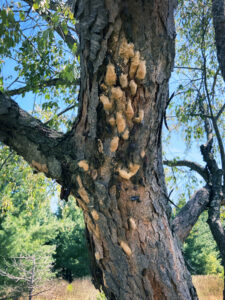By Bill McNee, DNR Forest Health Specialist, Oshkosh;
Bill.McNee@wisconsin.gov or 920-360-0942

Numerous tan-colored spongy moth egg masses on a bur oak in Walworth County. / Photo Credit: Bill McNee, Wisconsin DNR
The Wisconsin Department of Natural Resources (DNR) encourages property owners to examine their trees for spongy moth egg masses and determine whether control measures are needed this spring.
Spongy moths thrive in warm and dry weather. Even if weather conditions are more typical this spring and summer, the current spongy moth outbreak — which defoliated a state-record total of 373,000 acres of woodland last year — will likely continue and spread.
The pest is generally considered established across most of Wisconsin except the western third of the state. High spongy moth populations are most likely to be seen within parts of the quarantined area but may be present in non-quarantined counties. Looking at egg mass numbers on a specific property is the best way to determine if there is a potential problem.
Property owners with oak, birch, crabapple, aspen, willow and linden (basswood) trees should be exceptionally watchful because the caterpillars of this invasive insect prefer these species. However, they will feed on many other kinds of trees and shrubs.
To know whether spongy moths are on your property, look for their egg masses. They are tan-colored lumps about the size of a nickel or quarter. Egg masses are typically found on trees, buildings and other outdoor objects. They may also be found inside protected places like firewood piles and birdhouses. Egg masses produced in 2023 will feel firm and appear darker in color than older egg masses, which appear faded, feel spongy and do not contain viable eggs. Egg mass hatch usually begins in mid-to-late April in southern Wisconsin.
Horticultural oil (available from many lawn and garden centers) can be applied when temperatures are above freezing to prevent the masses from hatching. You can also use a knife, chisel, or similar utensil to scrape unhatched egg masses into a can of soapy water; leave them in the water for a couple of days before disposing of them in the trash.
Insecticide treatments, including foliage sprays and soil and trunk injections, may be a suitable control option after the caterpillars have hatched. A professional treatment is likely needed when there are high numbers of egg masses on large trees. Insecticide treatments are most effective when the caterpillars are small (mid-to-late May in southern counties and late May to early June in northern counties).
When low or moderate numbers of egg masses are present, physical controls can often be used to reduce pest impacts and make insecticide unnecessary.
Host trees that were heavily defoliated or drought-stressed in 2023 are at a higher risk of dying, especially if they are not protected with insecticide and lose a high percentage of their leaves again this year. Low-vigor oak trees are likely infested by the native beetle and twolined chestnut borer, contributing to tree decline and death. Consult an arborist or DNR forester for additional management recommendations.
Planning for insecticide treatments early can ensure trees will be able to receive treatment ahead of a last-minute rush when pesticide application businesses may already be very busy. Resources for finding a qualified pesticide applicator include the Wisconsin Arborist Association, the International Society of Arboriculture, and a local phone book.
Find additional information on the spongy moth online, including egg mass oiling and removal, physical controls and insecticide application.

Wisconsin DNR invasive forest insects program coordinator Andrea Diss-Torrance demonstrates scraping a spongy moth egg mass off a tree while making a video on the subject for the DNR. / Photo Credit: Wisconsin DNR
